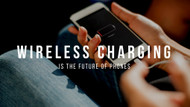Wireless Charging is the Future of Phones
Published by Carly on Mar 23rd 2018
With the recent releases of the iPhone X, 8, and 8 Plus, wireless charging has been a big topic in the mobile device world. Wireless charging is the future of smart phone charging and perhaps even charging for all electronic devices. It’s time to embrace wireless charging, because soon enough, it is going to take over.
We’ve got answers to all of your wireless charging questions!
What is wireless charging?
Wireless charging allows you to charge a mobile device battery without plugging it in. It uses electromagnetic induction technology , similar to that of rechargeable toothbrushes. This technology allows your device to charge by simply touching a special mat or stand. Qi Wireless Charging is the universal standard for wireless charging.
Which phones are compatible with wireless charging?
The following devices are already compatible with Qi Wireless Charging:
- Apple iPhone: 8, 8 Plus, X
- Samsung Galaxy: S9, S9+, Note 8, S8, S8+, S7, S7 Edge, Note 5, S6, S6 Edge
- LG: V30, G6, G4, G3
- Microsoft Lumia: 1520, 1020, 930, 929, 938, 920
- Google Nexus: 4, 5, 6, 7
- Blackberry Priv
If you have one of these devices, congratulations! All you need to do is purchase a wireless charging mat or stand and you are ready to go.
How can I enable wireless charging on my phone?
Don’t have one of the devices listed about, but you’re still interested in wireless charging? No worries, because you can enjoy the luxury of wireless charging, too.
If your phone has a lighting port (like an iPhone), you can use this Qi Wireless Charging Receiver . The receiver plugs into your lighting port with an ultra thin ribbon cable which wraps around to lay flat on the back of your phone. Then, you’ll simply lay your phone on a charging mat or stand.
If you don’t have a lighting port, but instead have a Micro USB port, this is a similar devic e compatible with Android phones.
What are the best wireless chargers?
So you’re in the market for a wireless charging, but which one should you choose? Well, there are some things you should first consider. You decide which type of charger you want; Qi Wireless Charges are available as pads or stands. With the pads, your phone will lay flat while charging, but the stands will prop up your phone. There are no truly functional differences between the two, so this decision comes down to personal preference.
Also, it is important to remember that you do not have to purchase the wireless charger sold by your phone’s manufacturer. Any Qi Wireless Charger will work with any wireless compatible device (though your phone’s retailer doesn’t want you to know that). This is a good thing to know because this opens up the price range a bit more for wireless chargers, which do not have to be expensive to be effective.
Officially manufactured for the iPhone 8 and iPhone X, the Mophie Wireless Charging Base is a mid-range model when it comes to price. This is a great option for wireless charging, however, it can only hold one device at a time (so no charging your iPhone and Apple Watch together).
Also, officially made for iPhone, the Belkin Boost Up Wireless Charging Pad features a sleek design, but is on the pricier range of wireless chargers. Still, it is one of the best available.
One of the most affordable options is the RAVPower Fast Wireless Charger . This simple, inexpensive Qi charger gets the job done at a fraction of the cost compared to most of its competitors.
What is the future of wireless charging?
According to CNET, “Wireless charging is meh, but it is going to get way better ”. There is a lot of promise on the horizon for wireless charging of mobile devices, and more. Techradar claims that the US Federal Communications Commission has certified the first ever “power-at-a-distance” charger. The WattUp Mid Field Transmitter would allow you to charge multiple devices all at one time, as long as they are within a few feet of the charging device. Your phone, or whatever you want to charge, would require a special receiver, which could be built into the device or attached externally. There is also a charger in the works that would charge devices from 15 feet away , however, only the 3-foot transmitter has been approved.
The future of wireless charging is bright, so jump right in and get to charging!

